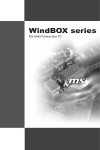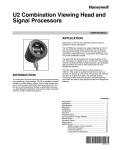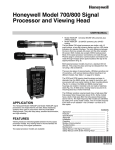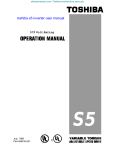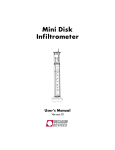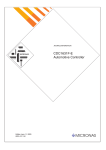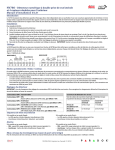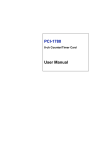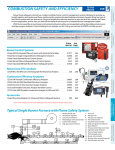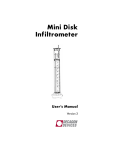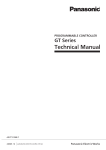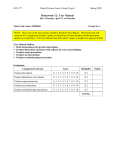Download Data Sheet
Transcript
U2 Combination Viewing Head and Signal Processors USER MANUAL APPLICATION Each sensor in the U2 has a different response which is suitable for certain applications. The UVTRON tube detector has a peak response at 210 nm and is primarily for gas flame monitoring. This UV detector using pulse technology is the best for low NOx gas burners and where a solid state sensor, using flicker technology, does not provide satisfactory results. The solid state UV photodiode has a peak response at 310 nm. This sensor is suitable for gas, oil and coal. The principle of flame monitoring is flicker frequency based. User selectable high pass filters are used to reject signals that are from background radiation. INTRODUCTION The Honeywell U2 flame monitoring system combines sensing and processing in one package. The U2 is available in several models to provide different options. Each model includes one, two or three sensors which share the same optical axis. The U2 can be connected either through a detachable connector or a pipe fitting for installations with conduit. Refer to the table below for model numbers and options. The solid state IR photodiode has a peak response at 1400 nm. This sensor is suitable for low NOx oil and coal burners, low excess air oil burners, and burners with a limited view from a windbox front plate. The principle of flame monitoring is flicker frequency based. User selectable high pass filters are used to reject signals that are from background radiation. Contents Introduction ....................................................................... Application ........................................................................ Specifications ................................................................... Approvals .......................................................................... Installation ........................................................................ Accessories ...................................................................... Operation .......................................................................... Troubleshooting ................................................................ Communicating Through Modbus .................................... Manual Setup ................................................................... Automatic Setup ............................................................... Maintenance ..................................................................... Safety Manual ................................................................... Safety Function of the Uniscan 2 ......................... Proof Test Procedure ........................................... Proof Test Interval ................................................ Product Decommissioning ................................... 1 1 2 3 4 6 6 9 10 13 14 15 22 23 23 23 24 66-2071EP-01 U2 COMBINATION VIEWING HEAD AND SIGNAL PROCESSORS Table 1. Available models and associated features. Model Connector Connection U2-1010 Pipe Fit Connection (3/4 in. NPT) SSUV Sensor IR Sensor X X X U2-1010-PF X X X X U2-1010-PF-050* X X X X U2-1010-PF-100* X X X X U2-1012 X UVTron Sensor X U2-1012-PF U2-1016 X X U2-1016-PF U2-1018 X X X X X X U2-1018-PF X X X X X * The U2-1010-PF-050 has a 50-ft (15m) pigtail and the U2-1010-PF-100 has a 100-ft (30m) pigtail. 3. All models include the following: 1. Electronic check (no mechanical shutter) for self-check of the system. 2. 24 VDC input 4. 5. 6. Ten (10) flicker frequency filters for solid state UV and IR sensor (model dependent) Gain selection Eight (8) different file configurations Resettable fuses SPECIFICATIONS Power: 22-26 VDC, 120 mA max Paint: Silicone-free powder coat Output relay contacts SPST: 2 A, 30 VDC or 250 VAC Mounting/Process Connection: 1” NPT female NOTE: Refer to for Fig. 9 and Fig. 10 mounting examples. Ambient temperature: -40 to 70 ºC (-40 to 158 ºF) Pipe Fit Conduit Connection (-PF): 3/4” NPT Enclosure: IP66 FFRT: 1-3 second nominal, 2-4 second maximum NOTE: Optional air cooling for housing is available for applications with higher ambient temperatures. Please contact your distributor or Honeywell for assistance. Time Delay On: 0-3 seconds Fuses: Automatically resettable Weight: 2.8 kg (6.1 lbs) NOTE: If one of the devices is triggered due to high power draw, disconnect power from the system for a minimum of 30 seconds then reconnect power. Physical Dimensions: Diameter: 11.7 cm (4.6 inches) Length: 15.5 cm (6.1 inches) 66-2071EP—01 2 U2 COMBINATION VIEWING HEAD AND SIGNAL PROCESSORS APPROVALS The U2 is a FM approved combustion safeguard and flame sensing system. The U2 also carries the following approvals. Table 2. Approvals. Market FM-U.S. Pipe fit series (-PF) Connector series CLASS I, II, III DIV 1 GROUPS A, B, C, D, E, F, & G, T6 *Not for use in acidic or aliphatic hydrocarbon atmospheres. **Must be sealed at the enclosure. XP / I / 1 / ABCD / T6 Ta = -40 to +70 °C; DIP / II, III / 1 / EFG / T6 Ta = -40 to +70 °C; I / 1/ AEx d IIC / T6 Ta = -40 to +70 °C; 21/ AEx tb IIIC / T85°C Ta = -40 to +70 °C; CLASS I, II, III DIV 2 GROUPS A, B, C, D, E, F, & G, T5 DIP / II, III / 2 / EFG / T5 Ta = -40 to +70 °C; NI / I, / 2 / ABCD / T5 Ta = -40 to +70 °C; I / 2 / AEx nA nC IIC / T5 Ta = -40 to 70 °C; IP66 21/ AEx tb IIIC / T85°C Ta = -40 to +70 °C; FM-Canada XP / I / 1 / ABCD / T6 Ta = -40 to +70 °C; DIP / II, III / 1 / EFG / T6 Ta = -40 to +70 °C; I / 1/ Ex d IIC / T6 Ta = -40 to +70 °C; DIP / II, III / 2 / EFG / T5 TA = -40 to +70 °C; NE / I, / 2 / ABCD / T5 TA = -40 to +70 °C; I / 2 / EX NA NC IIC / T5 TA = -40 to 70 °C; IP66 IEC IECEx FMG 13.0023X Ex d IIC T6 Gb IP66 Ex tb IIIC T85C Temperature range: -40 to +185 ºF (-40 to +70 ºC) IECEx FMG 13.0023X NCC/ Inmetro IECEx FMG 13.0023X IECEx FMG 13.0023X Ex d IIC T6 Gb IP66 Ex tb IIIC T85C Temperature range: -40 to +185 ºF (-40 to +70 ºC) Certificate number NCC 14.03257X Segurança Ex nA nC IIC T5 Gc IP66 Ex tb IIIC T85C Temperature range: -40 to +185 ºF (-40 to +70 ºC) Certificate number NCC 14.03257X Segurança INMETRO KTL Ex nA nC IIC T5 Gc IP66 Ex tb IIIC T85C Temperature range: -40 to +185 ºF (-40 to +70 ºC) INMETRO Ex d IIC T6 Gb Ta= -40 to +70 °C Ex nA nC IIC T5 Gc Ta= -40 to +70 °C Ex tb IIIC T85C Db Ta= -40 to +70 °C IP66 Ex d IIC T6 Gb Ta= -40 to +70 °C Ex nA nC IIC T5 Gc Ta= -40 to +70 °C Ex tb IIIC T85C Db Ta= -40 to +70 °C IP66 NCC 14.03257 X NCC 14.03257 X IECEx FMG 13.0023X Ex d IIC T6 Gb IP66 Ex tb IIIC T85C Temperature range: -40 to +185 ºF (-40 to +70 ºC) Certificate number KTL 14-KB4BO-0575X IECEx FMG 13.0023X Ex nA nC IIC T5 Gc IP66 Ex tb IIIC T85C Temperature range: -40 to +185 ºF (-40 to +70 ºC) Certificate number KTL 14-KB4BO-0574X Special conditions of use for IECEx as indicated below. NOTES: Special Conditions for Safe Use: 1. Consult the manufacturer if dimensional information on the flameproof joints is necessary. 2. The aluminum surface of the Honeywell U2 flame monitoring system may store electrostatic charge and become a source of ignition in applications with a low relative humidity (<30 %) where the aluminum surface is relatively free of surface contamination such as dirt, dust or oil. Cleaning of the painted surface should only be done with a damp cloth. 3. The apparatus has flying lead conductors that exit the enclosure. A suitably certified Ex d or Ex e terminal box is required to be connected to apparatus enclosure for completing to external supply circuits. WARNING “Lockout” requires operator action. To prevent explosion in hazardous atmospheres, do not open housing. * Not including aliphatic hydrocarbons (hexane) and acids atmospheres in Class I, Division 1 locations. ** To reduce the risk of ignition of hazardous atmospheres, an approved sealing fitting is required at the enclosure in Class I, Division 1 locations. 3 66-2071EP—01 U2 COMBINATION VIEWING HEAD AND SIGNAL PROCESSORS INSTALLATION Grounding and Shielding 4. IMPORTANT 5. Installer must be a trained, experienced flame safeguard service technician and should be familiar with the equipment operation and limitations and be aware of any applicable local codes and regulations. 1. 2. 3. Connect a safety ground to the U2 housing (if applicable). The U2 and all associated cable/conduit must be at least 12 inches (31 cm) from any source of high energy or voltage (for example, igniter equipment). Install a ground wire from the ignition transformer case to the igniter assembly. Ensure all igniter wires and cables show no signs of wear. Replace any igniter cables or wires that are frayed or cracked. The U2 must be electrically isolated from the burner front. a. Electrical isolation can be accomplished by installing an Ultem locking coupler adapter (R-518-PT12 or R-518-PT12L) in conjunction with a locking coupler (R-518-CL12-HTG or R-518-CL12-PG) between the viewing head flange and the burner mount. b. The purge air line should also be isolated from the viewing head. This can be accomplished by installing any insulating material, for example a rubber hose, in between the purge air line and the U2. Wiring U2 models with a pipe fitting have slightly different wiring than models with a removable connector. Refer to the table and diagram below for wire function, connection, and comments. Honeywell C12S cable colors are referenced for the Connector (CAB22) wires. NOTE: If the fault and flame contacts are wired to 220 VAC voltage and cable runs are long, it may be necessary to use isolating/interposing relays to reduce induced noise. Table 3. U2 Wires and their function. Pipe Fitting Connection (CAB19) Connector (CAB22) Function Comments Drain wire Shield Cable shielding Tie to ground (black) Black Yellow/Green Ground Power ground Red Black #10 Power Connect to 22-26 VDC Green Yellow #3 Relay common Common for both flame and self check relays Yellow Yellow #4 Self check relay Normally open contact Grey Yellow #2 Flame relay Normally open contact Brown Yellow - RS 485 communication Modbus Connection White White + RS 485 communication Modbus Connection Blue Black #7 Future use Future use Orange Black #8 Current output 0-20 or 4-20 mA output corresponding to flame count. Use ground as return line. Purple Black #9 File select Grounded = parameter file 0 +24V = parameter file 1 NOTE: The file input wire should not be left unconnected or in an unknown state. If not being used or if using the default file 0, connect the file input wire to ground. 66-2071EP—01 4 U2 COMBINATION VIEWING HEAD AND SIGNAL PROCESSORS Purge Air NOT USED The U2 does not have a purge air connection directly on it, so purge air must be provided via the mounting method. Refer to the ACCESSORIES section and Fig. 7 for suggested U2 mounting. Purge air is used to prevent very hot gases from reaching the U2 by continuously blowing cooler air through the sight pipe. Air required is about 0.13 Nm3/min (5 SCFM) delivered at 25 mm (1 in.) above the maximum back pressure as measured at the “Y” or “T” section of the purge air connection. Use a flexible air supply line, to allow for repositioning of the U2 and sight pipe until a final and permanent position has been decided. A continuous flow of air must be maintained in order to reduce conducted heat and to keep the sight pipe and U2 lens free of dirt and debris. The air supply must be clean, free of oils and water, and preferably cool. In order to electrically isolate the U2, the purge air line should be installed using an insulating material, such as a rubber hose, in between the purge air line and the U2. YELLOW WHITE YELLOW 2 BLACK 10 BLACK 9 YELLOW 3 BLACK 8 YELLOW 4 BLACK 7 YELLOW/GREEN SHIELD M33313 Fig. 1. Connector Pinout. NOTES: — — — It is recommended to use shielded pairs of cable. However, any cable can be used as long as analog output and communication cables are individually shielded. Honeywell offers C12S cable with 12 conductors for use with the U2. 18 AWG is recommended Wiring must be in conduit or tray as permitted by code. Hazardous location wiring must meet area classifications. Clearance Make sure there will be sufficient room to remove the U2 for servicing. Mounting Honeywell offers a range of swivel mounts, both pipe thread or flange mounting for use with sight pipes or direct windbox mounting. Refer to the section “Accessories” on page 6. Mounting and Sighting Mounting is 1 in. NPT (F). Refer to Fig. 7 for suggested U2 mounting. Before beginning the actual installation, determine the best location for mounting the viewing head based upon the following factors: Viewing Head Sighting The sighting of the U2 should be parallel to the center line of the burner in the direction of the flame. If used, the sight pipe should be mounted as close to the center line as possible so as to sight along the flame rather than across the flame. Doing so will ensure continuing flame detection under changing load conditions. Refer to Fig. 4, 5 and 6. Pressure The U2 lens will withstand 500 psi. If the U2 will be exposed to pressures over 500 psi, contact your distributor or Honeywell for guidance. Utilizing a sighting or the sight pipe aimed at the root of the flame (where the turbulent combustion air mixes with the flame) is a good starting point for optimizing the sighting. Where practical, using a swivel mount to “zero-in” on the highest signal will assure the maximum performance. The optimum scanner location is parallel to the burner center line. The use of a swivel mount allows for line of sight adjustment, where practical to use. Temperature The U2 can withstand an ambient temperature of 158 ºF (70 ºC). The case temperature of the housing must not exceed 158 ºF (70 ºC). Purge air will help reduce conducted heat through the sight pipe and flange. A heat insulating Ultem locking coupler adapter (R-518-PT12, R-518-PT12L) is required and will reduce the conducted heat, however, direct radiation can cause the housing case temperature to exceed limits. If the ambient heat (direct radiation) is excessive, then a fiber optic extension should be considered. The extension uses a fiber optic cable assembly between the sight pipe and the U2, allowing the U2 to be placed further away from the heat source. Refer to the Fiber Optic Manual 69-2683 or contact your distributor or Honeywell for assistance with fiber optic selection and pricing. Examples of U2 installation with and without a swivel mount are shown in Fig. 9 and Fig. 10. If using a sight pipe, the diameter should be large enough to allow a reasonable field of view and to allow for adjustment of the swivel mount angle. Pulverized coal, unburned fuel, smoke, oil mist, dirt, dust and other impurities in the fuel can act as masking agents that attenuate the ultraviolet radiation that the flame emits. As well, sour gas (H2S) can readily absorb 200nm UV wavelengths, reducing the amount of ultraviolet radiation reaching the detector. Care should be taken to select the proper viewing head for the fuel used. Additionally, the contaminants that mask UV can be diluted by providing a strong flow of air through the sight pipe to clear a viewing path through the attenuating material. Refer to the Purge Air section of this manual. The U2 models also have an internal sensor for measuring temperature. To access the temperature reading at the U2, refer to Fig. 2. It may also be desirable to sight the detector at an area containing fewer masking agents such as near the burner nozzle or near the entrance of the combustion air. Increasing 5 66-2071EP—01 U2 COMBINATION VIEWING HEAD AND SIGNAL PROCESSORS Insulating locking coupler adapters (R-518-PT12 and R518-PT12L) – 1 in. NPTM Ultem adapters insulate the viewing head from heat and are used with the R-518-CL12-PG purge air adapter or the R-518-CL12-HTG locking coupler. The R518-PT12L has a quartz lens. the viewing area of the detector by shortening the sight pipe or by increasing the diameter of the sight pipe can also reduce the attenuating effect of masking agents. With low NOx gas burners, the UV radiation is usually much less in intensity and spread out. Relatively high readings can be obtained from all over the furnace when many burners are on. This is particularly true when flue gas recirculation is used. There will however, be a relatively stronger signal near the “root” of the flame and the more intense spot should be located during the aiming or sighting process. The “root” or intense spot may be further out than with the standard gas burner so it is imperative that a swivel mount be used when making sighting adjustments. Swivel mounts (M-701-1, M-701-2, M-701-2-FLG, M-701-2SS, M-701-3, M-701-3P, M-701-4) – All have 1 in. NPTF viewing head connections on one end with varying process connections including 2 in. pipe slip-on, 2 in. NPTF, 2 in. flanged, 2 in. NPT in stainless steel construction, 4.5 in. flanged with 3 bolts, 3 in. NPTF and 2-bolt flanged. Locking coupler (R-518-CL12-HTG) – Used with the R-518PT12 and R-518-PT12L insulating locking coupler adapters. Process connection end is 1 in. NPTF. As an example of proper sighting challenges, detecting flame in a sulfur recovery unit can present a challenge for IR flame monitors. The IR detector will detect natural gas used for the warm-up of the reactor. Usually the combustion air is turbulent enough to cause a good flicker signal. Connector (R-518-10) – Quick disconnect connector for all non-pipe fitting U2 models. NOTE: Connector is not included with the non-pipe fitting models. Order separately along with cable and required mounting accessories. When sour gas is introduced and the natural gas is shut down, the flame signal could potentially drop off or drop out entirely due to a complete change in the flicker content for the existing U2 sighting. In this case, optimizing the flame signal for the sour gas by “zeroing-in” on this flame, and not the warm-up burner, may be beneficial. Cable (C12S) – 12 conductor cable with braided shield. Sold per foot. NOTE: Cable is not included with the non-pipe fitting models. Order separately along with connector and required mounting accessories. Once optimizing the sighting for the sour gas has been completed, the signal level could potentially be too low on the natural gas. In this case, using the UV detector for this application may be beneficial. It may be beneficial to use two sets of set points for Flame On and Flame Off, one set for proving and detecting the natural gas flame and the other for proving and detecting the sour gas flame. The switch-over from the two different files should be done when removing the natural gas burner. This can be implemented from the burner management system. The switch-over and the use of different files with independent settings is explained in the sections “File” on page 8 and “Manual Setup” on page 13. Cable+ Connector (ASY964) – Pre-assembled 15-foot (4.7m), 12-conductor cable (C12S) with quick disconnect (R518-10) for all U2 non-pipe fitting models. Fiber Optic System Compatibility – The U2 models are compatible with the Honeywell FASA fiber optic extension products. The S550FOAD, S550FOADY-FT and S550FOADYFT-AL adapters are applicable. Contact your distributor or Honeywell for assistance with fiber optic selection and pricing. USB to RS422/RS485 Converter (COMMOD) – Protocol converter for use with external communication to a remote computer. Another factor that needs to be considered when aiming the viewing head is the load condition of the boiler. The flames from a burner can be radically different at different loads. This is one of the reasons for choosing an optimum sighting initially that will maximize signal swing due to changing loads. OPERATION ACCESSORIES IR and UV Detectors The following accessories are available for use with the U2. See Table 1 on page 2 to determine which sensors are active in your U2 model. Orifice Disks (kit M-702-6) – Used to reduce the signal brightness in cases where the signal brightness is too strong. Located immediately in front of the lens, it will reduce the amount of signal to the sensors. Bag assembly contains orifice disks and retaining rings. Orifice disks come with 3/8, 1/4, 3/16 and 1/8 inch diameter holes. Contact your distributor or Honeywell for guidance in using orifice disks. The UVTron tube sensor responds to UV radiation from different fuel flames. The UVTron sensor generates pulses that are electronically conditioned to provide output indicated on the U2 display from 0000 to 3425 units. The signals from the UVSS solid state sensor are processed based on flicker principle using FFT (Fast Fourier Transform). User selectable high pass filters are used to reject signals that are from background radiation. Locking coupler with purge port (R-518-CL12-PG) – Adapter is a 1 in. NPTM locking quick disconnect/cam and groove coupler with 1/2 in. NPT purge port. Used with R-518PT12 and R-518-PT12L insulating locking coupler adapters. 66-2071EP—01 The signals from the IR solid state sensor are processed based on flicker principle using FFT (Fast Fourier Transform). User selectable high pass filters are used to reject signals that are from background radiation. 6 U2 COMBINATION VIEWING HEAD AND SIGNAL PROCESSORS occurrence. There are several tasks that require intelligent interaction between the viewing heads and the signal processor. If all of the interactions do not occur properly, the flame relay will open. Each sensor allows independent adjustment for gain. For flicker-based sensors, there is also a high pass filter setpoint. To further assist in flame discrimination setup, adjustable “Flame On” and adjustable “Flame Off” thresholds are also provided. The Flame On threshold and Flame Off threshold can then be set to monitor the target burner flame but to reject background radiation from other burners. User Interface A touch wheel located on the back of the U2 is used for operator interface. The configuration menu is simple and easy to follow. Full character 4 digital scrolling LED displays are visible in the dark or sunlight. Individual sensor LEDs (3 total located below the display) flash to indicate the output of each sensor (green = UVT, Blue = SSUV, Red = IR). The upper right green self-check LED provides status of the hardware while the upper left red “Flame On” LED provides status of the flame relay (main safety device). In order to energize the flame relay, the flame count must be higher than the programmed “Flame On” threshold for greater than the “Time Delay” value. Once the flame relay is energized, the flame signal can fall below the programmed Flame On threshold setting. As long as the flame signal remains above the programmed “Flame Off” setting, the system will continue to operate. When the flame signal falls below the programmed “Flame Off” threshold, it will not be deenergized until after the “FFRT” (flame failure response time) expires, unless “Flame On” is detected. NOTE: The number of LEDs is model dependent. The touch wheel is designed like an iPod™ to allow for slow or fast changes by moving a finger slower or faster around the back glass. Alternatively the user may tap (-) or (+) to make changes. Tap ENTER/STORE to enter a menu or store selected data. Tap BACK to return to the previous menu. Exiting all the menus will display the current flame count. The U2 menus are detailed below. The U2 includes a self check relay which should always be energized whenever the U2 has power. The self check relay is de-energized (failsafe) when an internal fault is detected. The self check relay is factory wired in series with the flame relay. One additional contact is provided for alarm purposes. Self-Checking There is a small processor in all viewing heads and it is possible that it could fail and produce erroneous viewing head pulses. The self-check circuitry guards against such an HONEYWELL U2 PROGRAMMING TWO BUTTON INTERFACE (BACK AND ENTER) EVERYTHING ELSE CAN BE DONE BY SCROLLING INTERFACE TECHNIQUES: INTERFACE MODES: TAP: PRESS FINGER ON BUTTON AND REMOVE. SCROLL: PRESS FINGER ON GLASS AND MOVE FINGER IN CIRCLES (TWIRL). RAMP: HOLD FINGER ON THE + OR - BUTTON. FLAME DISPLAY: TAP BACK (MAY REQUIRE MORE THAN ONE TAP). HELP: TAP + OR - (FROM DISPLAY). LAST MENU: TAP ENTER, MOVE THROUGH MENU WITH TAPS OR SCROLLS. ADJUST MODE: TAP ENTER FROM ADJUSTABLE MENU ITEM, CHANGE VALUE USING ANY TECHNIQUE. NO YES MODE: CHANGE TO YES AND TAP STORE. FACTORY DEFAULT 4 SUB MENUS VERSION HOURS FILE DEFAULT ON OFF °F OR °C READ ONLY WRITE ONLY RS485 DEFAULT 0->20 OR 4->20 IRDA PARITY 127 °F AUTO FILTER AUTO GAIN ADDRESS - GAIN TUBE UV3425 GT32 GAIN SS UV- G 32 COMMS NONE ODD EVEN BAUD 2400 9600 38400 115200 BACK A000 4800 19200 57600 PANEL FILE *F01 TD03 HELP TIME OUT MIN 0000 RT01 GAIN MA OUT- FLAME OFF- 0000 FILTER IR- LAST MENU FFRT PANEL LOCK GAIN IR- ENTER STORE TIME DELAY- F 09 FILTER SS UV- HELP 0600 GI32 FI04 GM32 FLAME ON0800 M33314 Fig. 2. User interface menu overview. NOTE: If sensor is not available in your model, then no menu item will exist for sensor setting. See Table 1 on page 2 to determine which sensors are active in your U2 model. 7 66-2071EP—01







